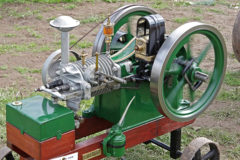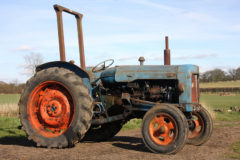1971 Albion Reiver tipper
Posted by Chris Graham on 3rd July 2021
David Reed tells the story of Johnny Murphy’s 1971 Albion Reiver tipper, which he’s owned three times since the late 1990s!

Johnny’s 1971 Albion Reiver tipper (left) together with his 1977 Ford D Series.
Johnny Murphy, from Huddersfield, has a wide-ranging collection of classic commercials that includes a couple of interesting tippers, one of which – a 1971 Albion Reiver – he’s been associated with since the 1990s.
More recently, however, that was joined by a 1977 Ford D Series. “I’ve always liked six- and eight-wheeled tippers,” he explained. “I remember seeing them when I was young; most were rough and ready back in the day, dented and rusty. But I admired those rough diamonds, as I did the old fairground lorries that were being used at that time too.” Perhaps unsurprisingly then, Johnny likes to have his tippers in ‘working’ condition, dents and all.
Only 400 made
Both of his tippers started out with Ready Mix Concrete (RMC) as six-wheel concrete mixers. The oldest is GJD 273J, a 1971 Albion Reiver RE229, that’s powered by an AEC 505 engine matched to a 10-speed Range Change gearbox and spring brakes on the rear axles. “Only 400 were made, and most worked for RMC,” Johnny told me.

Johnny Murphy at the door of his 1971 Albion Reiver.
The Reiver has certainly had a varied history, after its time as a mixer in South Wales, it was converted to a recovery vehicle. “Most Reivers were retired by RMC between 1981 and ‘83, and I came across this one by accident in the early 1990s. I was delivering a beer tanker to South Wales when it drove by while I was having a break in a lay-by.” Not one to let an opportunity pass him by, Johnny set off in pursuit, passing the Reiver on a dual-carriageway and managing to get the owner’s name and number from the door.
That owner turned out to be Brian Cox, who had a recovery and garage business near Monmouth. “I rang him and asked him if I could video the Reiver in action, just like I’ve done with many classics that were still working in the 1990s,” Johnny explained. Brian duly invited Johnny to his garage. “Not only did I manage to capture it on video, Brian let me drive it for some 20 miles,” hr added.
In 1997 Brian Cox decided to retire the Reiver and got in touch with Johnny to see if he wanted to buy it, and a deal was done. “I bought it without the recovery gear, and drove it back to Huddersfield at 38mph,” Johnny said.
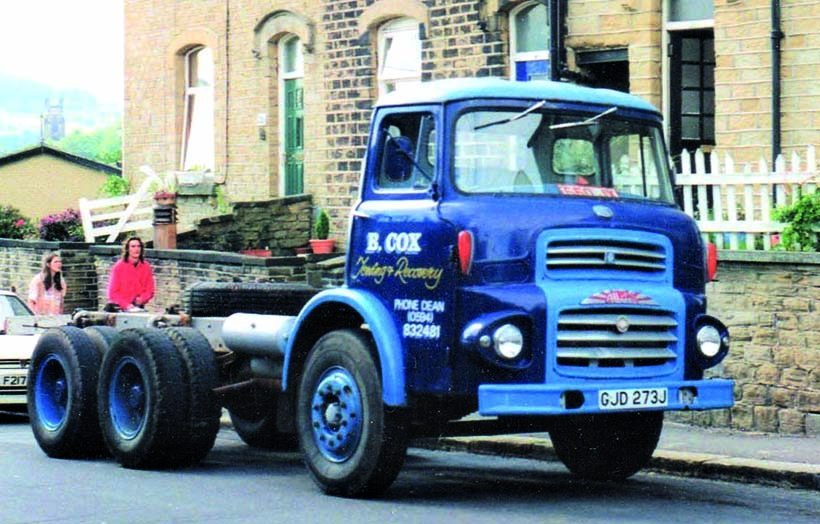
The 1971 Albion Reiver in Huddersfield, after being driven all the way from South Wales.
Mixer or tipper?
The big question, though, was whether to rebuild the Reiver as a mixer, or convert it into a tipper? “It all depended on whether I could find a mixer drum or not.” However, within a year Johnny heard of another Reiver RE229 that was for sale in Dudley. “This one had an AEC 505 engine but, more importantly, also came with a working mixer drum,” he said. This was FFD 332K, a 1972 Albion Reiver that was one of five mixers ordered by RMC. “But the order was cancelled, so it was bought by Dudley Concrete and spent its working life in the Midlands.”
Johnny duly travelled down to Dudley to have a look at the mixer and, with a deal completed, it was brought back to Huddersfield for restoration; a process that took three years. But with Johnny concentrating on the restoration of this mixer, he had to let GJD 273J go. “Andrew Garlick from Buxton had been interested in buying it from me for a while so, as I was busy with FFD 332K, I let him have it.”
So GJD 273J was taken down to Buxton where Andrew and his brother, Chris, set about restoring it. “They removed all the cab panels and wings, and welded all the cab up, “Johnny said, “It was a major job that I would have had to do if I’d kept this Reiver.” Other work that Andrew and Chris did included re-bushing the suspension. “They also had the good idea of replacing the original diffs with ones from a Leyland Constructor, which increased its speed to 45mph. They then fitted some twin rams and an aluminium tipping dropside body on the back.”
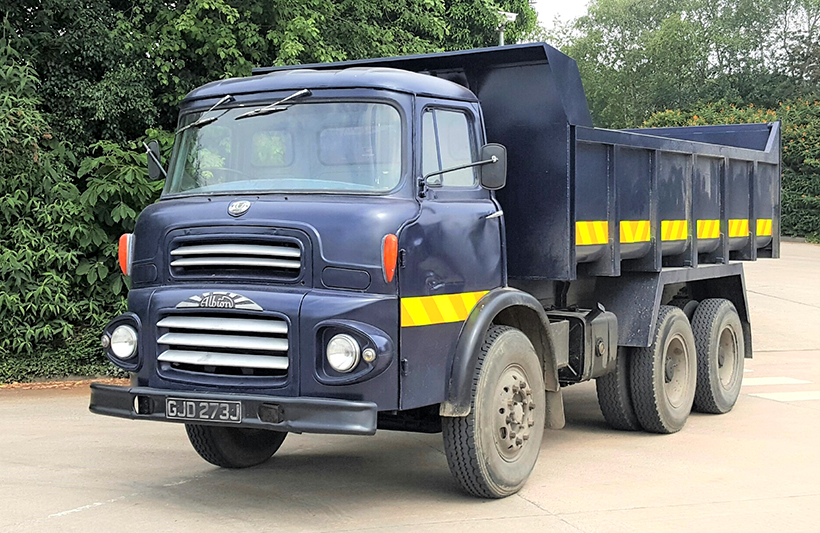
The Albion Reiver after returning from Ireland, painted dark blue and with Irish warning stripes.
Reiver’s return!
Eventually though, due to loss of storage, Johnny was offered the chance to buy the Reiver back. “Although I was still restoring the mixer at the time, I eventually agreed to buy it.” Initially though, work was envisaged rather than pure preservation, as Johnny was lowering his back garden. “I decided that the tipper would save us money if we used it instead of skips for clearing our back garden, which kept my wife happy. So I collected it on the company low-loader.”
There was some work to do, though. “My eldest son, Gareth, put in some hard graft on the Reiver,” Johnny said. Work included some cab tidying, and the suspension was re-adjusted and re-set, with a bumper, lamp brackets and mudguards being fitted, too. We then got the tipping pump working and had the vehicle MoT’d.”
And yes, it was useful when renovating the garden, having the dropsides made it easy to load with a plank and a wheelbarrow. “It sounded fantastic climbing the Yorkshire hills,” he added. “It also did a lot of internal work for my current, long-time employer, Hoyer UK, too.”
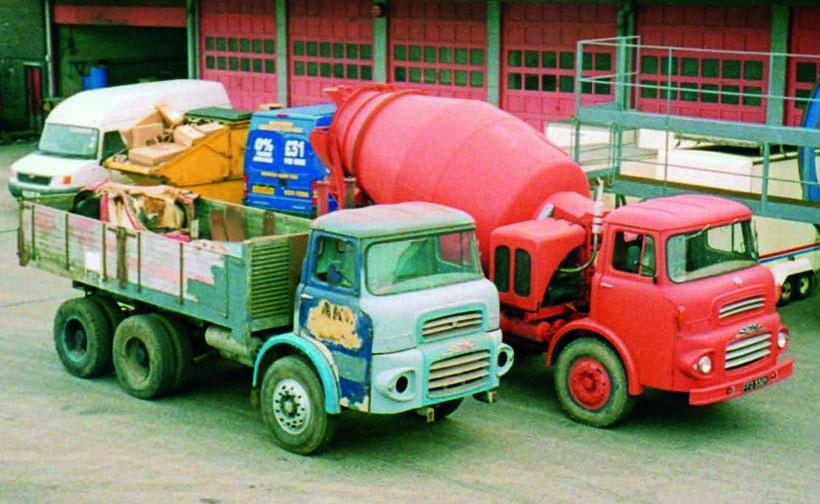
The mixer and the tipper under restoration.
So, Johnny now had two Reiver RE229s with both the mixer and the tipper attending many rallies over the following years, including The Cheshire Run and Thornes Park, in Wakefield. “I also took it on The Trans Pennine Run which is my favourite event, by far,” he said.
The tipper, as well as the mixer, was also involved in a lot of television work. “It was featured on Heartbeat and George Gently,” Johnny added. “When it comes to lorries, film companies like to employ vehicles that look as if they’ve been well-used, to make the scene appear realistic.”
Changing looks
Johnny does occasionally like to change the look of his lorries though, with the Reiver having a partial re-paint in 2010. “I kept the same blue livery but without the red grille. I also put my name on the door,” he said.
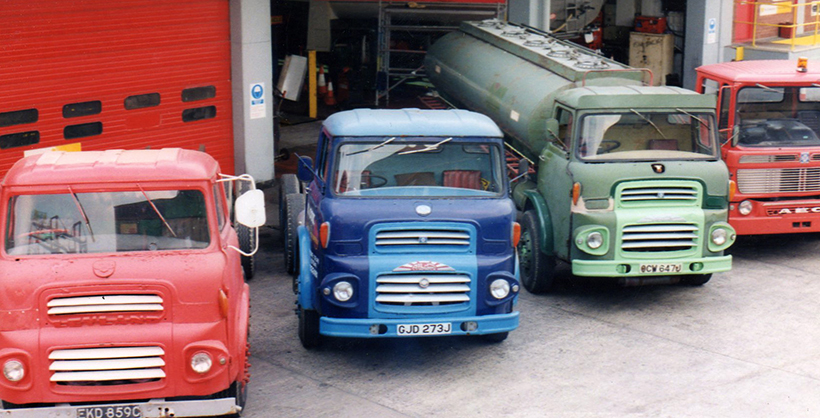
The Reiver with the other LAD-cabbed vehicles in Johnny’s collection.
Although Johnny enjoyed driving the Reiver, there were some aspects of it that he was unhappy with. “I never really liked its small, aluminium tipper body, even though the dropsides were very useful.” Johnny’s tipper had a big fan though. “Despite the Reiver never really being for sale, I knew that my friend from Ireland, Alex Kelly, always had a liking for it. He’d first seen the it in 1997, just after I’d bought it, when he visited me after a Trans Pennine Run.”
After some discussion, Alex made Johnny a very good offer for the Reiver, which he accepted. “I’d taken it to many rallies, so agreed to the sale,” he added. Johnny also liked the fact that Alex was intending to build a proper ‘muck shifter’ steel tipping body for the Reiver. “That was the type that I had always dreamt of it having, but I’d never found one in reasonable shape or the right dimensions, anywhere.
Alex and his friends came over in July 2015 to collect the Reiver, driving it to their base near Dublin via the Irish ferry, and work on the tipper soon began. “Alex removed the old body and built a brand-new, steel ‘muck body’ from scratch, working from drawings and using his past experience to complete the job,” Johnny explained. “He also rebuilt the heads on the engine, replaced the rear hub oil seals and relined the rear axle’ brakes.”
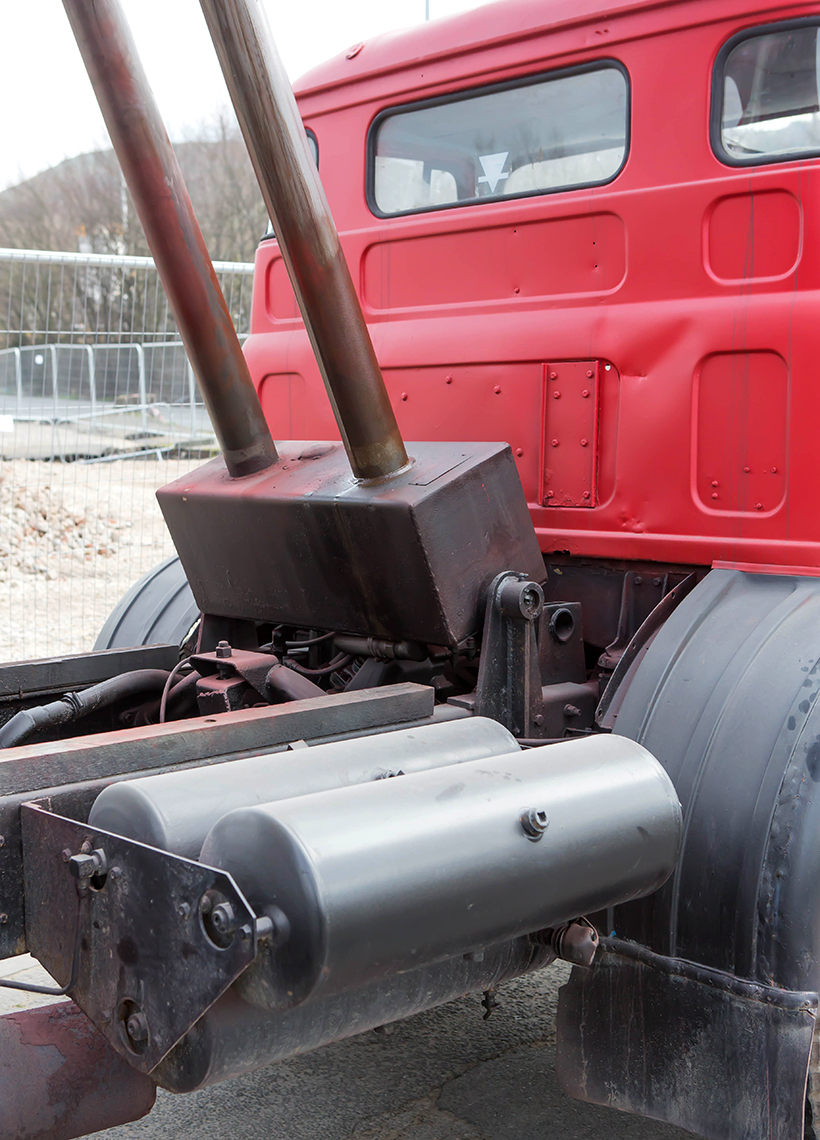
The tipping rams on the Reiver.
Hazard markings
The Reiver had a change of colour, too, with Alex painting it in a Royal Blue livery, replicating some LAD-cabbed six-wheelers that he’d seen when younger. “He also fitted the Irish Hazard markings on the side of the vehicle, to finish it off,” Johnny confirmed. The Reiver still retained its ‘working’ look though. “When Alex was rubbing down the passenger door, he discovered a very deep dent in the panel,” Johnny said, “but he decided not to repair it, with the damaged door giving the tipper a ‘typical’ Reiver battle scar!”
But Johnny had regretted selling the Reiver, and Alex knew it. “I was looking for another LAD six-wheeler, but an email from Alex changed everything. He kindly agreed to sell the Reiver back to me.” So, three years after selling it, Johnny made the crossing to Dublin in June 2018, and came back in his old Reiver, now sporting a new look. “I followed Alex, who was driving his restored AEC Mercury tipper, to the docks in the Reiver, smiling from ear to ear,” he recalled.
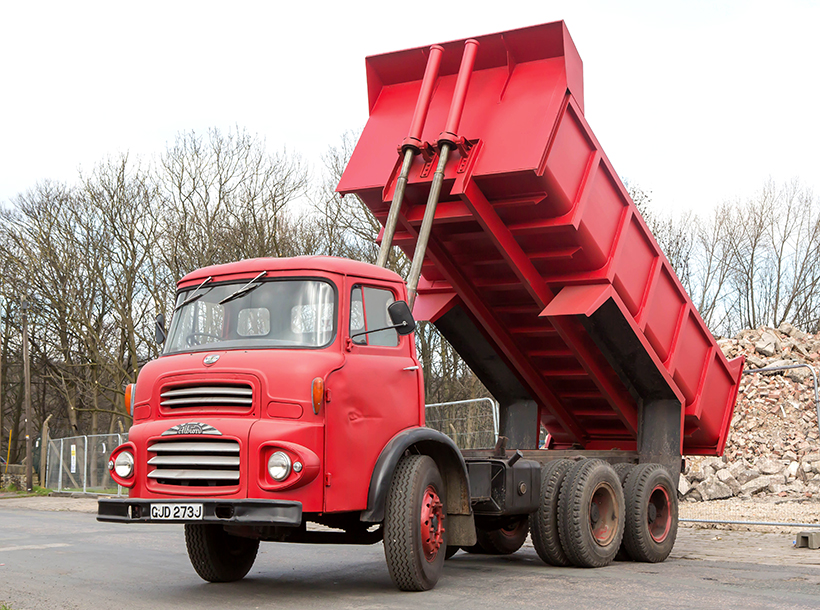
Johnny’s 1971 Albion Reiver after re-painted in its red, working livery.
A few repairs were needed, however. “These included replacing air pipes and rebuilding the control valve on the gearbox for the low- and high-range with new O rings,” Johnny said. The Reiver also had a worn track rod end, and the track rod was found to be bent as well. “I think it got that from its days in the swamp land at Hoyer,” Johnny explained. “Fortunately, James Stott helped me out, as he had a spare rod with perfect ends, which I fitted.”
With these jobs completed, the Reiver appeared at a number of runs and events. “It was still wearing the Irish stripes on the side which I removed, as they weren’t well liked,” Johnny continued. “But I wanted to change the dark blue livery as, in a dull light, it looked black, and people thought it was an ex-NCB coal lorry.”
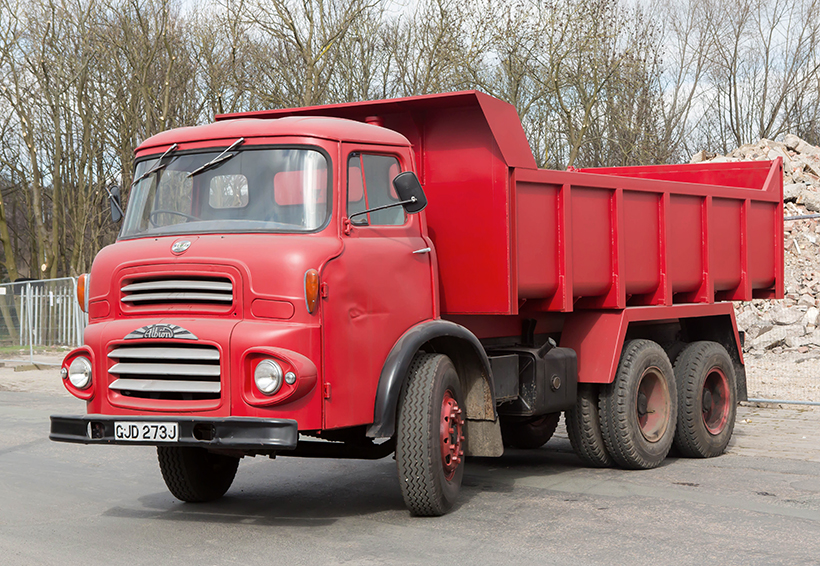
Working appearance
Johnny knew exactly how he wanted the Reiver to look. “I had it painted red by D&S Coachworks of Penistone,” he said. “They gave the tipper a semi-gloss finish to age it and make it look like a working lorry.” The lorry replicates similar vehicles that Johnny remembers working in West Yorkshire. “They were painted bright red but very few had names on them at the time,” he said.
This tipper isn’t the only one that Johnny has owned over the years. “I have had a number of them, all of which have been sold on to new homes.” Some of the rarer ones included a Guy Big J8 8wh, an Austin FJ 6×4, an Austin FFK 6×2, a Foden S40 8wh, and an ERF KV eight-wheeler that was registered 899 ABD.
One vehicle that was a particular favourite was DLU 745C, a 1965 Guy Invincible that was one of 120 similar vehicles supplied to Pioneer Concrete, of Plymouth, for mobile cement mixer work. After about six years, it moved onto the fairgrounds with T Whitelegg and later Tommy Rowland, carrying a generator for both owners. It ended up with John Horner of Heysham who’d bought it as a chassis cab from Tom Carron of Coventry, in 1988 and converted to a tipper, where Johnny had actually videoed it working! “It ended up in Scotland, where it was stored for 20 years, before I bought it,” Johnny said. “It looked great in its working condition, and its now with a friend, Tony Gothard, in Tilbury.”

One tipper that is still in Johnny’s collection, though, is a rare Hino ZM 6×4. “Alex Kelly found it for me in Ireland and helped with its shipping,” Johnny said. But that’s a story for another day.
The latest acquisition to the fleet though is OPH 459R, a 1977 Ford D Series tipper. “I’d wanted a Ford 6×4 tipper with the Perkins V8 for a long time,” Johnny explained. “Before I bought OPH 459R, I looked at VPK 543M, a 1974 Ford D series, that was in a Leicester lorry breaker’s yard, but I turned it down as it was too rough and the engine was seized.” That D Series was later bought by Paul Bibby and superbly restored in its original livery.
For a money-saving subscription to Classic & Vintage Commercials, simply click here



